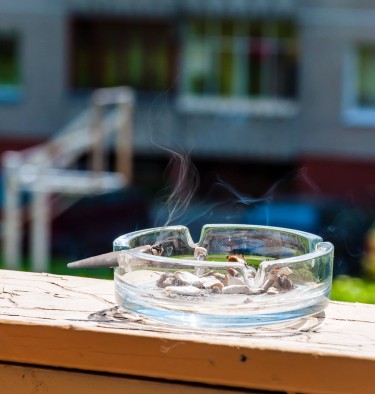
This is the story of Tom. Tom suffered from chronic pain for years, enduring countless surgeries and seeking relief in various forms. Finally, he gathered the courage to pursue a medical marijuana license, and it changed his life. He found solace in cannabis, as it alleviated his pain and allowed him to regain a sense of normalcy. For the first time in years, Tom experienced a life without constant suffering.
However, as Tom went about his daily life, embracing the newfound relief provided by medical marijuana, a knock on his door brought his world crashing down. He had been served with a lawsuit, filed by his neighbor who claimed that the years of breathing in Tom’s marijuana smoke had harmed her health. Unbeknownst to him, his own home had become a battleground, pitting his medical needs against his neighbor’s concerns.
This isn’t fiction – this really happened, and should concern every cannabis smoker in the US.
In a recent case in Washington D.C., a court ruled that a man, Thomas Cackett, is forbidden from smoking cannabis inside his home after his neighbor, Josefa Ippolito-Shepherd, sued him. Ippolito-Shepherd argued that the marijuana smoke from Cackett’s residence seeped into her home, causing severe health issues. The court ordered Cackett to refrain from smoking cannabis inside his home, under the risk of being held in contempt of court.
While Cackett testified that he relied on cannabis for pain relief and expressed empathy for his neighbor, the judge ruled in favor of Ippolito-Shepherd, citing the need to protect a neighboring homeowner’s right to the full use and enjoyment of their property. The court decision could still be appealed.
The case raises important questions about the rights of cannabis users and their neighbors, as well as the challenges that arise when conflicting interests clash.
“Experts in secondhand smoke” emphasized the porous nature of shared walls, floors, and ceilings in multi-unit dwellings, stating that cannabis smoke can permeate more extensively than tobacco smoke. They noted that while tobacco smoke may cause headaches and irritations, marijuana smoke can also result in getting high for non-smokers.
Advocates for cannabis legalization, such as Adam Eidinger, see this case as a call to action to establish outdoor public smoking areas, where individuals can consume cannabis without impacting their neighbors. However, critics argue that finding a balance between individual freedoms and the well-being of others is essential.
As with these kinds of stories, I’m going to provide the old “Reginald Perspective” that will highlight some of the absurdities of the claims by these so called “secondhand smoke experts”, and why this case needs to be appealed – and if Tom doesn’t have the money, the cannabis community needs to reach out and pitch in.
Before we continue to discuss the importance of this case – we must first talk about the alleged claims that were made by “secondhand smoke experts” regarding the permeability of cannabis smoke through shared walls, floors, and ceilings in multi-unit dwellings. Additionally, it was suggested that non-smokers exposed to secondhand cannabis smoke can get high. It is essential to critically evaluate these assertions and rely on scientific evidence to provide accurate information on these topics.
And that’s precisely what we’re going to do.
Evaluating Permeability of Cannabis Smoke:
The claim that cannabis smoke can permeate extensively through porous materials such as walls, floors, and ceilings requires careful examination. One cannot simply say things to win court cases, it must be founded in science and reason.
Several scientific studies have investigated the behavior of smoke particles, including those from cannabis, in indoor environments. Notably, the permeability of cannabis smoke is influenced by factors such as particle size, ventilation, and filtration systems.
A study published in the Journal of the Air & Waste Management Association in 2019 examined the transport of particulate matter, including cannabis smoke, in residential buildings. The researchers concluded that while particles from tobacco smoke can travel through shared ventilation systems, the extent of particle migration is limited and does not necessarily result in significant exposure in neighboring units. This study challenges the notion of extensive permeation of cannabis smoke through shared structures.
Furthermore, a study published in the journal Aerosol Science and Technology in 2013 investigated the penetration of smoke particles through materials commonly found in homes, such as gypsum wallboard and plywood. The researchers found that larger particles, such as those present in cannabis smoke, exhibited limited penetration through these materials. These findings suggest that the claim of extensive permeability is not supported by scientific evidence.
It means that those experts are not what they claim because it doesn’t take a rocket scientist to figure out how weak that argument really was.
Addressing the “Getting High” Claim:
Another assertion made was that non-smokers exposed to secondhand cannabis smoke can experience psychoactive effects and get high.
However, the psychoactive effects of cannabis are primarily attributed to delta-9-tetrahydrocannabinol (THC), the main psychoactive compound in the plant. It is important to understand that the concentration of THC in secondhand cannabis smoke is significantly lower than in directly inhaled smoke. Especially if it was “filtered through a wall” as claimed by the experts.
A study published in the journal Drug and Alcohol Dependence in 2010 examined the effects of secondhand cannabis smoke exposure in non-smokers.
The study found that exposure to realistic levels of secondhand cannabis smoke did not result in detectable levels of THC in the blood, suggesting that non-smokers are unlikely to experience psychoactive effects or get high from secondhand exposure. These findings contradict the claim that non-smokers can get high from secondhand cannabis smoke.
However, it’s important to note that people can get high from smoking a non-psychoactive material when they are deceived into believing that it is a psychoactive material. In other words, they can be “placebo-ed” into thinking they are high.
Now, I’m not claiming that the plaintiff in the afore mentioned case was not affected by the odor of her neighbor, but it’s hard to believe that she got the “dizziness” she claims she got from the plant. Rather, it seems like psychosomatic suggestion as a result of decades of programming by her pals “The US Government”.
To further explore why the plaintiff is self-suggesting her “health side effects” we’ll compare the smoke density and material density of buildings.
Comparing Smoke Density and Material Density:
To provide a better understanding of the physical properties involved, it is important to compare the density of cannabis smoke with that of typical building materials.
Cannabis smoke consists of tiny particles suspended in the air, while walls, floors, and ceilings are composed of dense materials. The density difference between smoke particles and building materials impedes the ability of smoke to permeate through solid surfaces significantly.
Additionally, the presence of smoke filtration systems, such as HVAC (Heating, Ventilation, and Air Conditioning) systems equipped with appropriate filters, can further minimize the movement of smoke particles between different units. These systems effectively capture and remove airborne particles, reducing the potential for smoke migration.
We don’t know for sure if the defendant in the case had any of these elements on, however, this wasn’t even considered in the case. The mere fact that the logic of these alleged experts weren’t challenged makes me think that Tom nor his lawyers expected a court to rule against banning someone from smoking in their own home as this opens up a whole bag of constitutional issues.
The Possible implications of this ruling
Banning someone from smoking cannabis in their own home can have significant implications for cannabis consumers and potentially encroach upon their constitutional rights.
The case described in the article, where a court ordered a D.C. resident to cease smoking cannabis inside his home due to a neighbor’s complaint, raises concerns regarding individual privacy, personal autonomy, and the broader implications for cannabis legalization.
The right to privacy is a fundamental aspect of individual liberty protected by the U.S. Constitution. The Supreme Court has recognized this right as encompassing personal choices made within the confines of one’s home. By prohibiting individuals from consuming cannabis in their private residences, a precedent is set that potentially infringes upon this constitutional protection.
It sets a worrisome precedent where personal preferences and choices are subjected to the scrutiny and control of neighbors and the legal system.
Moreover, such bans can undermine the progress made in cannabis legalization efforts.
As more states and jurisdictions move towards decriminalization and legalization, it is essential to establish frameworks that respect individual rights and the autonomy of consumers. Imposing restrictions on the use of cannabis within private homes can undermine the intent and purpose of these laws, limiting the ability of individuals to fully exercise their rights within the confines of their own property.
Additionally, singling out cannabis consumers for restrictions not imposed on individuals who engage in legal activities raises questions about equity and fairness.
It creates a disproportionate burden on individuals who rely on cannabis for medical purposes or as a legal recreational substance. This selective targeting of cannabis users potentially violates principles of equal protection under the law, treating them differently from individuals engaged in other lawful activities within their homes. If there’s no ban on smoking tobacco, then this is singling out a specific group of people under the law…
To ensure a fair and balanced approach, regulations regarding cannabis consumption should be carefully crafted, respecting the rights of individuals while addressing valid concerns related to public health and nuisance. Striking a balance between individual rights and community interests is crucial in navigating the complexities of cannabis legalization and preventing the erosion of constitutional rights.
This is why this is an important story for cannabis consumers and I urge any lawyers or groups to rally together and fight this in the courts. We need to etch out our space within the community and while it might be inconvenient for some that people have a right to consume on their own homes/properties – then so be it.
The fact of the matter is that we’re talking about fundamental rights here…so let’s not let non-consumers shape the law according to their wills.
READ MORE ABOUT THIS CASE BELOW…
YOU CAN NOW SUE YOUR NEIGHBOR OVER MARIJUANA ODORS AND WIN?
- SEO Powered Content & PR Distribution. Get Amplified Today.
- EVM Finance. Unified Interface for Decentralized Finance. Access Here.
- Quantum Media Group. IR/PR Amplified. Access Here.
- PlatoAiStream. Web3 Data Intelligence. Knowledge Amplified. Access Here.
- Source: http://cannabis.net/blog/opinion/banned-from-smoking-weed-in-his-own-home-judges-ruling-opens-a-pandoras-box-for-medical-marijua




